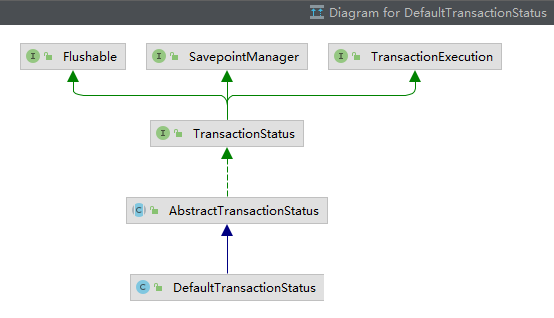Spring事务框架的第二部分,今天来分析TransactionStatus。
用来记录事务执行过程中的状态的,最终决定该事务能否提交、是否需要回滚等。
TransactionStatus:
public interface TransactionStatus extends TransactionExecution, SavepointManager, Flushable{
/**
* Return whether this transaction internally carries a savepoint,
* that is, has been created as nested transaction based on a savepoint.
* This method is mainly here for diagnostic purposes, alongside
* {@link #isNewTransaction()}. For programmatic handling of custom
* savepoints, use the operations provided by {@link SavepointManager}.
* @see #isNewTransaction()
* @see #createSavepoint()
* @see #rollbackToSavepoint(Object)
* @see #releaseSavepoint(Object)
*/
boolean hasSavepoint();
Flush the underlying session to the datastore, if applicable: for example, all affected Hibernate/JPA sessions.
This is effectively just a hint and may be a no-op if the underlying transaction manager does not have a flush concept. A flush signal may get applied to the primary resource or to transaction synchronizations, depending on the underlying resource.
@Override
void flush();
}
他只定义了两个方法:
- hasSavepoint:返回这个事务是否包含了savepoint,也就是说,是否基于嵌套事务创建了一个savepoint。savepoint的概念前面的文章已经分析过。
- flush:这个应该是和Hibernate或JPA相关的,具体作用暂时不管了,不研究Hibernate相关的东西。
没了。
但是,这个接口继承了3个接口:TransactionExecution, SavepointManager, Flushable,我们简单看一眼:
TransactionExecution
这个接口很简单,是事务状态的一个通用接口,定义了当前事务是否是一个新事务的获取方法、设置当前事务为回滚状态、获取事务是否已经完成的方法等。
/**
* Common representation of the current state of a transaction.
* Serves as base interface for {@link TransactionStatus} as well as
* {@link ReactiveTransaction}.
*
* @author Juergen Hoeller
* @since 5.2
*/
public interface TransactionExecution {
/**
* Return whether the present transaction is new; otherwise participating
* in an existing transaction, or potentially not running in an actual
* transaction in the first place.
*/
boolean isNewTransaction();
/**
* Set the transaction rollback-only. This instructs the transaction manager
* that the only possible outcome of the transaction may be a rollback, as
* alternative to throwing an exception which would in turn trigger a rollback.
*/
void setRollbackOnly();
/**
* Return whether the transaction has been marked as rollback-only
* (either by the application or by the transaction infrastructure).
*/
boolean isRollbackOnly();
/**
* Return whether this transaction is completed, that is,
* whether it has already been committed or rolled back.
*/
boolean isCompleted();
}SavepointManager
提供3个方法:创建保存点、回滚到保存点、释放保存点。
Object createSavepoint() throws TransactionException;
void rollbackToSavepoint(Object savepoint) throws TransactionException;
void releaseSavepoint(Object savepoint) throws TransactionException;Flushable
不说了,就是上面的那个flush方法。
AbstactTransactionStatus & DefaultTransactionStatus
AbstactTransactionStatus持有事务的几个重要状态,业务执行后,Spring事务管理器需要通过状态判断事务是提交或者是回滚。
private boolean rollbackOnly = false;
private boolean completed = false;
@Nullable
private Object savepoint;Spring事务管理机制中TransactionStatus的最终落地实现是DefaultTransactionStatus,代码就不贴出了,比较简单。
其实我们通过对TransactioStatus的分析能够得出一个结论,那就是有savepoint的事务的回滚是通过TransactionStatus实现的。
TransactionStatus持有事务对象transaction,事务保存点savepoint是保存在transaction中,最终通过调用transaction的rollbackToSavepoint回滚事务到存储点。
好了,TransactionStatus就分析到这儿。
